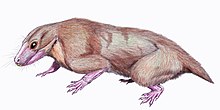| Ericiolacerta Temporal range: Early Triassic
~ | |
|---|---|

| |
| Ericiolacerta parva | |
| Scientific classification | |
| Domain: | Eukaryota |
| Kingdom: | Animalia |
| Phylum: | Chordata |
| Clade: | Synapsida |
| Clade: | Therapsida |
| Clade: | †Therocephalia |
| Family: | †Ericiolacertidae |
| Genus: | †Ericiolacerta Watson, 1931 |
| Species: | †E. parva
|
| Binomial name | |
| †Ericiolacerta parva Watson, 1931
| |

Ericiolacerta is an extinct genus of small therocephalian therapsids from the early Triassic of South Africa and Antarctica.[1][2] Ericiolacerta, meaning "hedgehog lizard" (from the Latin ericius, "hedgehon" and lacerta, "lizard"),[3] was named by D.M.S. Watson in 1931.[1] The species E. parva is known from the holotype specimen which consists of a nearly complete skeleton found in the Lystrosaurus Assemblage Zone within the Katberg Formation of the Beaufort Group in South Africa,[1][3] and from a partial jaw found in the Lower Triassic Fremouw Formation in Antarctica.[2] Ericiolacerta was around 20 centimetres (7.9 in) in length, with long limbs and relatively small teeth.[1] It probably ate insects and other small invertebrates. The therocephalians – therapsids with mammal-like heads – were abundant in Permian times, but only a few made it into the Triassic. Ericiolacerta was one of those. It is possible that they gave rise to the cynodonts, the only therapsid group to survive into post-Triassic times. Cynodonts gave rise to mammals.
- ^ a b c d Watson, D.M.S. (1931). "On the skeleton of a bauriamorph reptile". Proceedings of the Zoological Society of London. 101 (3): 1163–1205. doi:10.1111/j.1096-3642.1931.tb01056.x.
- ^ a b Colbert, Edwin H.; Kitching, James W. (1981). "Scaloposaurian reptiles from the Triassic of Antarctica". American Museum Novitates (2709): 1–22.
- ^ a b "Ericiolacerta". Paleofile. Retrieved 5 April 2022.